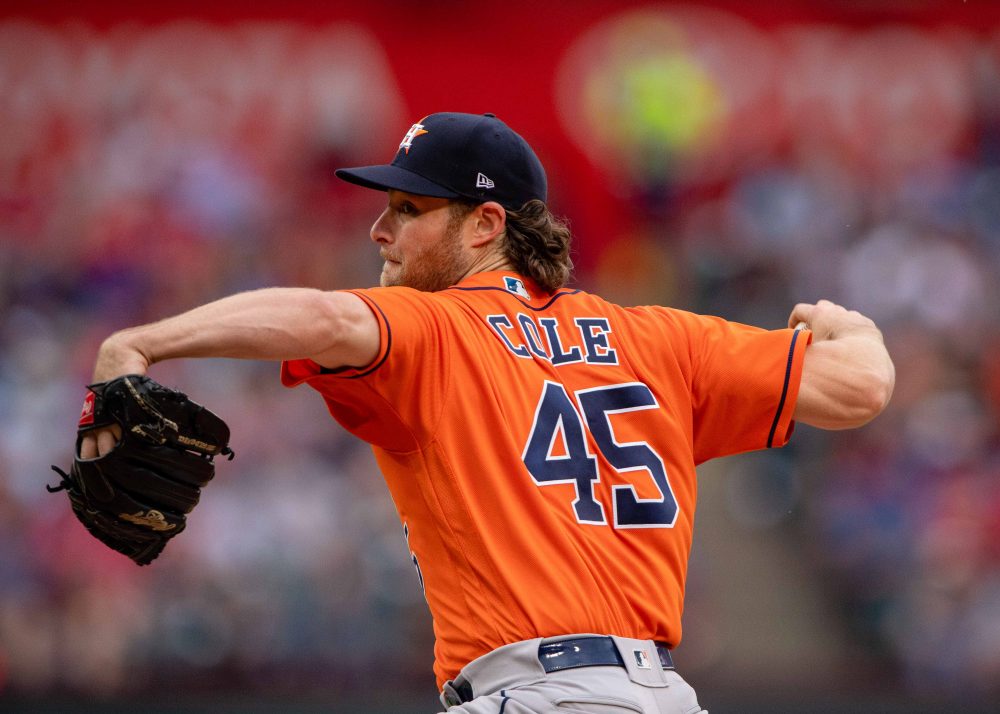
It’s only two starts, against a couple of below-average offenses, but Gerrit Cole’s first fortnight with the Astros has offered reason to believe that he’ll become for them what he never quite became for the Pirates: a full-fledged ace. He’s fanned 22 opposing batters in 14 innings, allowing just one run and 10 total baserunners.
Some of what he’s done is easy to explain, too. He’s increased his slider usage, at the expense of his fastball, and in particular he’s all but shelved his sinker (that favorite toy of erstwhile Pittsburgh pitching coach Ray Searage) and focused on his four-seam heater. We all expected that to happen.
Other changes Cole has made, however, are harder to describe, and they suggest that the Astros’ ability to makeover and make the most of top-flight starting pitchers runs even deeper than we thought.
One problem Cole had during his last two seasons with the Pirates was that his fastballs were only good at missing barrels. Despite elite velocity and a wipeout slider, Cole struck out a batter per inning in just one season while with Pittsburgh—and that was his truncated 2014 campaign.
One reason for that was that his fastball lacked the kind of hop that induces whiffs. The total spin rate on his four-seamer was uninspiring, and the vertical movement on the pitch was mediocre. Things have changed.
Below are Cole’s fastball spin, movement, and whiff rate by year, from 2015-2018:
| Season | 4-Seam FB | Avg. Spin Rate (RPM) | Spin Axis (Degrees) | Vertical Movement | Whiff% |
| 2015 | 1636 | 2157 | 222.2 | 7.8 | 8.4 |
| 2016 | 773 | 2178 | 215.4 | 8.8 | 6.9 |
| 2017 | 1601 | 2163 | 221.9 | 8.7 | 9.1 |
| 2018 | 100 | 2331 | 214.8 | 10.2 | 18.8 |
My inexpert eye detects no significant difference in Cole’s mechanics. There’s been a noticeable change to his vertical release point, but a small one. More than anything else, he seems to be repeating that release a bit more consistently. Without a change in arm slot or basic mechanics, Cole has overhauled his fastball. He’s not throwing it harder—the opposite is true, though he’s still sitting on the sexy side of 95 miles per hour—but he’s getting more spin on the pitch, and that spin is closer to unadulterated backspin.
The combination of those things is giving his fastball better rising action than it’s had at any point in his big-league career. That movement (plus batters trying to be ready for the more serious threat of a breaking ball) is resulting in the kind of swing-and-miss results a fastball like his should always have enjoyed.
By the way, some of the same things can be said of Cole’s curveball, too, He’s throwing it more often than he has since he was just breaking into the majors, and with good reason. For one thing, it plays better off his predominantly four-seam, higher-rising heater than it did off his sluggish sinker. For another, it’s diving more than it has in the past.
Again, although he’s thrown just 30 total curves so far in 2018, we find that his spin rate on the pitch is higher, and that the pitch has taken on a truer 12-to-6 shape. It’s also dipped in velocity, more than his other stuff has, so it’s a really nasty change of pace for Cole, underscoring the extent to which the pitch was being wasted while he toiled under Searage and tried to dominate with Searage’s fastball-heavy, sinker-leaning philosophy.
The question, I guess, is from where these increases in spin rate are coming. The Astros enjoyed a similar spin-fueled breakout from Brad Peacock last year, but Peacock’s path to that epiphany is a bit clearer. He lowered his arm slot, something a few other guys who also boosted their spin also did in 2017. The people (like Kyle Boddy of Driveline Baseball) who make their living by espousing the value of spin rate and helping pitchers harness it remain mostly agnostic about any single means of improving spin rate. It’s clear, though, that certain pitchers have spin potential that lies dormant, until they’re able to make the adjustments in arm path or grip that unlock it.
For the most part, it seems to be the former. Perhaps, in some fairly subtle way, Cole is more mechanically efficient now, freer with the arm. Perhaps the Astros are doing some high-level, in-house pitch design voodoo that allows them to get the most out of every hurler on whom they lay their hands. (That would help explain not only Peacock, but Charlie Morton, and hell, even Justin Verlander’s very productive adjustments near the end of last season.)
In any case, Cole has been a monster so far, and if this is remotely sustainable the Astros are truly the best team in baseball. It’s increasingly clear, with each bat Cole’s heater misses, that the Pirates were unable to get what they should have gotten from their former no. 1 overall pick, and it’s exciting to see that Cole’s sensational stuff didn’t atrophy during years of misguided pressure to be a certain, less sensational type of pitcher.
Thank you for reading
This is a free article. If you enjoyed it, consider subscribing to Baseball Prospectus. Subscriptions support ongoing public baseball research and analysis in an increasingly proprietary environment.
Subscribe now